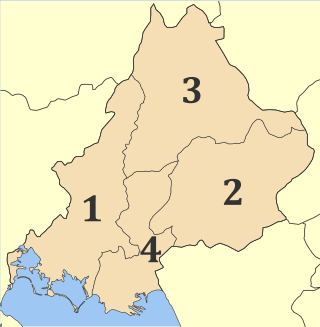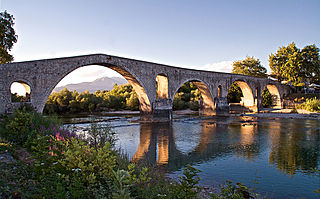Related Research Articles

Arta is one of the regional units of Greece. It is part of the Epirus region. Its capital is the town of Arta.

Vrisa is a village in the southern part of Lesbos island approximately 50 km from Mytilene. The village is named after one of the two girls Agamemnon took from Lesbos during the ten-year Trojan War. Five kilometers south is the famous Vatera beach. On June 12, 2017 Vrissa was severely damaged in an earthquake that struck approximately 12 km South of the town of Plomari. Most people could not return to their homes, rendering the village effectively a "ghost village".

National Road 5 is a single carriageway road in western Greece. It connects Antirrio, at the north end of the Rio-Antirrio bridge, with Ioannina in northwestern Greece, passing through Agrinio and Arta. The southern part, between Amfilochia and Antirrio, is part of the European route E55. The northern part, between Ioannina and Amfilochia, forms the European route E951. It passes on the east side of the Ambracian Gulf. In the future much of the traffic that used this road will be diverted to the new A5 motorway, which has already taken over parts of the road. Νear Arta there is a 200m. tunnel which opened in 1969

Arta is a city in northwestern Greece, capital of the regional unit of Arta, which is part of Epirus region. The city was known in ancient times as Ambracia. Arta is known for the medieval bridge over the Arachthos River. Arta is also known for its ancient sites from the era of Pyrrhus of Epirus and its well-preserved 13th-century castle. Arta's Byzantine history is reflected in its many Byzantine churches; perhaps the best known is the Panagia Paregoretissa, built about 1290 by Despot Nikephoros I Komnenos Doukas.

Būtingė is a small village at the coast of the Baltic Sea in the north of Lithuania, at the border to Latvia. It belongs to Palanga City Municipality, and is situated 17 km (11 mi) north of the town Palanga. The village has long time belonged to Livonia, and is a part of Lithuania since 1921.

The Kalavryta massacre, or the Holocaust of Kalavryta, was the near-extermination of the male population and the total destruction of the town of Kalavryta, Axis-occupied Greece, by the 117th Jäger Division (Wehrmacht) during World War II, on 13 December 1943.

Asha is a Zoroastrian concept with a complex and highly nuanced range of meaning. It is commonly summarized in accord with its contextual implications of 'truth' and 'right', 'order' and 'right working'. For other connotations, see meaning below. It is of cardinal importance to Zoroastrian theology and doctrine. In the moral sphere, aṣ̌a/arta represents what has been called "the decisive confessional concept of Zoroastrianism". The opposite of Avestan aṣ̌a is 𐬛𐬭𐬎𐬘 druj, "deceit, falsehood".
Dimari is a settlement in the municipality Georgios Karaiskakis, in the regional unit of Arta, Greece.

National Road 30 is a single carriageway road in central Greece. It connects the cities of Arta and Volos, via Trikala and Karditsa.
Pente Pigadia is a settlement in the municipal unit of Filippiada in municipality of Ziros, Preveza regional unit in Greece. It is part of the community of Kleisoura. Pente Pigadia is situated in the western foothills of the Xirovouni mountains, about 25 km north of Arta. Pente Pigadia was under Ottoman rule until the First Balkan War (1912–1913). On 21 October, 1912 (O.S.), the Battle of Pente Pigadia took place here.
Zawidy is a village in the administrative district of Gmina Reszel, within Kętrzyn County, Warmian-Masurian Voivodeship, in northern Poland. It lies approximately 3 kilometres (2 mi) south-west of Reszel, 19 km (12 mi) west of Kętrzyn, and 50 km (31 mi) north-east of the regional capital Olsztyn.
Polkajny is a village in the administrative district of Gmina Miłakowo, within Ostróda County, Warmian-Masurian Voivodeship, in northern Poland. It lies approximately 5 kilometres (3 mi) north-east of Miłakowo, 39 km (24 mi) north of Ostróda, and 38 km (24 mi) north-west of the regional capital Olsztyn.

The Church of the Parigoritissa or Paregoretissa is the 13th-century Byzantine metropolitan church of the Greek city of Arta. Part of the building used to house the Archaeological Collection of Arta.
Suvi Do is a village in the municipality of Tutin, Serbia. According to the 2002 census, the village has a population of 401 people.

The Archaeological Museum of Arta is a museum in Arta, Greece. It was established in 1973 as the Archaeological collection of Arta, and used to be housed in the 13th-century Paregoretissa church. The collection has now been moved to a brand new, purpose-built museum building which opened in 2009. The new museum building is located by the river, close to the historical bridge.
References
- ↑ "Limini Arta | Limini Information | Limini Weather | Limini Map | Greece.com". www.greece.com. Retrieved 2020-10-30.